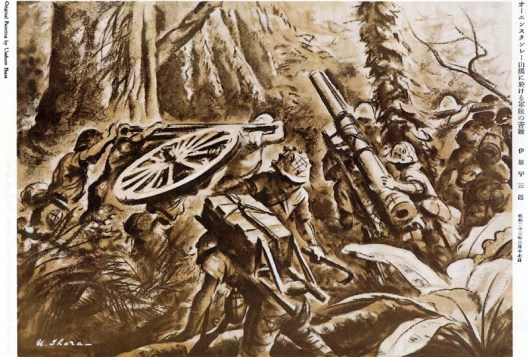
Japanese offensive in the Owen Stanleys, 21 July-26 September 1942.
Scene of a bitterly fought and difficult offensive in New Guinea during July-November 1942, in which the Japanese sought to capture Port Moresby by an overland route following the defeat of a naval operation to seize that place.
General Tomitaro Horii’s South Seas Detachment, meanwhile, were not relieved of their duty. It was decided that instead of coming across the beaches, they would attack overland, across the Owen Stanley Mountains which form the jagged spine of the Bird’s Tail. On July 21, Horii landed on the north shore of the Bird’s Tail in the area of the villages of Buna, Gona, and Sanananda, with around 6,500 men. They then attempted to hike across the mountains on the rough, 65-mile Kokoda Track, a trail which climbs to 3,380 feet through some of the most difficult terrain on earth. Opposing the Japanese were small understrength Australian units – and the land itself.
New Guinea was such a difficult place to wage war that the troops found it a triumph when they managed to march a mile a day through its dense forests. These jungles, with their slippery hillsides tangled in forests and foliage where the sun had never shown, and where visibility is often measured in inches rather than yards, were literally hell on earth for most troops who dared to challenge them.
Being located barely south of the equator gives New Guinea a climate in which a veritable encyclopedia of tropical diseases can flourish. The troops discovered that malaria was almost routine and maladies such as dysentery were actually routine.
Initially the South Seas Force under Major-General Tomitaro Horii made rapid and easy progress. The Papuan Infantry Battalion (a Melanesian unit 310 strong) and elements of the 39th Australian Battalion (a militia unit) clashed with the enemy near Awala on 23 July, before falling back on Kokoda. There a confused night action occurred on 28-29 July which resulted in the Australians being forced out. An attempt was made to retake Kokoda on 8 August, but both sides sustained severe casualties and the 39th Battalion and PIB were again obliged to fall back on Deniki. After several Japanese attacks were beaten off over the next week, on 14 August the Australians began a withdrawal along the jungle track (later dubbed the `Kokoda Trail’) over the Owen Stanley Range towards Isurava. For ten days after the abandonment of Deniki the Australians were not heavily pressed by the Japanese. During that time the 39th Battalion was joined by the 53rd Battalion and the headquarters of the 30th Brigade under Brigadier Selwyn Porter, and by 23 August the 21st Brigade commanded by Brigadier Arnold Potts had also arrived at Isurava.
While this augmentation of strength was invaluable to stopping the enemy’s progress, the commander of 1st Australian Corps at Port Moresby, Lieut.-General Sydney Rowell, faced a major problem in keeping up an adequate quantity of supplies to even such a meagre force as had been deployed forward. The tired 39th Battalion was accordingly withdrawn to ease the pressure.
On 26 August the Japanese resumed their advance, and fairly quickly Potts’ brigade was forced to mount a series of desperate delaying actions as it fell back first to Eora Creek on 30 August, then to Templeton’s Crossing on 2 September and Efogi on 5 September. Although Australian resistance was becoming increasingly better organised, and the Japanese beginning to feel the strain of their own extended supply line, the effectiveness of units involved in the defence was noticeably reduced through exhaustion and sickness entailed in operating over such harsh terrain. On 10 September Potts handed over command to Brigadier Porter, who withdrew his troops (now called `Maroubra Force’) to Ioribaiwa. The Japanese attacked here the next day, but made little progress. Not only was their advance losing impetus but the Australians were beginning to feel the benefits of the arrival of fresh units. By now the fighting along the track involved brigades of the seasoned AIF 7th Division under Major-General Arthur Allen, and on 14 September command in the forward area was passed to Brigadier Kenneth Eather.
Severe fighting continued around Ioribaiwa for a week, prompting a further withdrawal on 17 September to Imita Ridge, the last effective barrier which was virtually within sight of Port Moresby. This proved to be the limit of the enemy advance, since not only had the South Seas Force outrun its own supply lines but General Horii was ordered onto the defensive because of the reverse sustained by other Japanese forces in operations at Guadalcanal. After he received instructions to establish a primary defensive position on the north coast, he began withdrawing on 24 September. Under Eather’s determined leadership, the retiring enemy were followed back up the trail by the Australians until Kokoda was retaken on 2 November.
In the campaign to this point 607 Australians had been killed and 1,015 sustained wounds in battle; estimates put the rate of sickness at between twice to three times that of combat casualties. No overall figures for losses among the 6,000 troops committed along the track by the Japanese are available, but captured documents dated 2 November 1942 reveal that in the case of two of the five enemy battalions involved the numbers killed, wounded or sick were over 75 per cent of original strength.
Raymond Paull (1958) Retreat from Kokoda, London: William Heinemann; Dudley McCarthy(1959) South-West Pacific Area-First Year: Kokoda to Wau, Canberra: Australian War Memorial; Lex McAulay (1991) Blood and Iron, Sydney: Hutchinson Australia